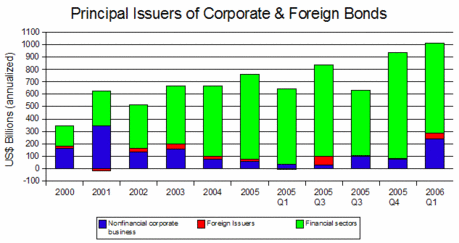Buyback Financing Helps Drive Up Interest Rates: Q1 2006
by John Schroy filed under Corporate Bonds, Equities, Corporate Managers
Massive issuance of bonds by non-financial corporations, largely to finance an extraordinary level of stock buybacks, helped force bond interest rates upwards in Q1 2006. (See Flow Table F212).
The annualized rate of bond issuance by non-financial corporate business rose to $240.4 billion in Q1 2006, four times the issuance rate of 2005.
The graph shows that, for years, the principal issuers of corporate bonds into the U.S. market have been the financial sectors (green bars) — mainly issuers of asset-backed securities raising funds for mortgages and consumer finance.
 Principal Issuers of Corporate & Foreign Bonds
|
||
Non-financial Corporations Raise Money For Buybacks
The annualized rate of issuance of corporate bonds by the financial sectors rose from $679.3 billion in 2005 to $725.4 billion in Q1 2006, while the financial sector’s share of the issuance market fell from 90% to 70% due to the extraordinary level of bonds issued by non-financial corporations.


